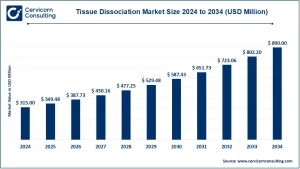Telehealth Market Overview
The global telehealth market was valued at USD 161.64 billion in 2024 and is forecasted to reach USD 871.56 billion by 2034, expanding at a CAGR of 18.35% (2025–2034).
Initially accelerated by the COVID-19 pandemic, telehealth has now become a core healthcare delivery channel. It is being widely used across primary care, specialty consultations, chronic disease management, mental health, and remote monitoring. The ecosystem spans hardware, software, and services, including service categories such as telemedicine, telemonitoring, and store-and-forward. Core enabling technologies include video conferencing, mHealth apps, wearables, and remote patient monitoring systems. Applications range from psychiatry and cardiology to radiology, oncology, and beyond.
In 2024, North America captured nearly 50% of the global revenue, with services and web-based delivery models dominating the segment landscape.
👉 Get a Free Sample: https://www.cervicornconsulting.com/sample/2562
Key Market Trends
-
Expansion of Remote Monitoring and Wearables
The shift from episodic to continuous care is accelerating with the use of wearables and RPM (remote patient monitoring) devices, particularly for conditions such as diabetes, cardiovascular disease, and respiratory disorders. -
AI Integration in Telehealth
Artificial intelligence (AI) is increasingly embedded within telehealth workflows, enabling smarter diagnostics, automated triage, and tailored treatment recommendations. AI also processes real-time data from connected devices to support proactive care delivery. -
Growth of Mental Health Teletherapy
Teletherapy adoption is soaring due to its accessibility, privacy benefits, and convenience. This has proven especially impactful in underserved areas where mental health support was traditionally scarce. -
Rising Adoption Among Older Adults and Rural Populations
Elderly, disabled, and rural patients are increasingly turning to telehealth, benefiting from reduced travel burdens and improved access to specialists. -
Dominance of Web-Based Delivery Models
Web-first platforms remain the largest revenue contributor (nearly half in 2024), with providers expanding services into chronic care, behavioral health, and tele-radiology.
Market Drivers
-
Growing demand for convenient access to care – Remote consultations are particularly popular for follow-ups, mental health, and chronic disease management.
-
Advances in digital technologies – Wider broadband availability, mobile connectivity, miniaturized devices, and secure cloud platforms make telehealth delivery more reliable.
-
Supportive policies and reimbursements – Pandemic-era regulatory reforms expanded coverage; many are now being made permanent, strengthening long-term adoption.
-
Healthcare cost savings – Telehealth lowers travel expenses, reduces clinic overheads, and optimizes resource use for providers and payers.
-
Demographic shifts – Aging populations and increasing prevalence of chronic diseases amplify the need for continuous monitoring and virtual care solutions.
Impact of Trends and Drivers
-
By Application
-
Chronic disease management: Enhanced by RPM and wearables, reducing hospitalizations.
-
Mental health: Strong growth fueled by teletherapy platforms.
-
Radiology and specialty consults: Expanding through store-and-forward and imaging solutions.
-
-
By End User
-
Healthcare providers: Leading adopters, representing over 50% of revenues in 2024, using telehealth to expand reach and efficiency.
-
Payers: Increasing adoption due to cost-containment advantages.
-
-
By Region
-
North America: Market leader, supported by robust digital infrastructure and reimbursement models.
-
Asia-Pacific: Highest growth potential, driven by large patient populations and digital health investments.
-
Challenges & Opportunities
Challenges:
-
Fragmented regulations and evolving reimbursement models.
-
Limited broadband/device access in rural and underserved areas.
-
Ongoing issues with data privacy, cybersecurity, and interoperability.
Opportunities:
-
Consolidation of integrated platforms combining AI, RPM, and care management tools.
-
Expansion of specialized services like tele-behavioral health, tele-cardiology, and tele-radiology.
-
Growing demand in emerging markets supported by public health initiatives.
Future Outlook
Growth will be driven by AI-powered diagnostics, wearable adoption, RPM innovations, and supportive government reforms, alongside the expansion of specialized telehealth services.
Emerging shifts include AI-assisted diagnostic workflows, fully integrated telehealth ecosystems, and increasing reimbursement parity with in-person care.
Summary
Telehealth has firmly transitioned into a mainstream pillar of healthcare delivery. With rapid technological adoption, evolving patient needs, cost advantages, and policy backing, the industry is primed for sustained global expansion. While infrastructure gaps and regulatory hurdles remain, the sector’s trajectory is shaped by rising opportunities across specialties, geographies, and patient demographics, making it one of the most transformative healthcare markets of the coming decade.
